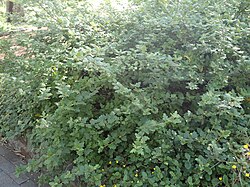Biology:Chorilaena
| Karri oak | |
|---|---|

| |
| Chorilaena quercifolia in Karwarra Gardens | |
| Scientific classification | |
| Kingdom: | Plantae |
| Clade: | Tracheophytes |
| Clade: | Angiosperms |
| Clade: | Eudicots |
| Clade: | Rosids |
| Order: | Sapindales |
| Family: | Rutaceae |
| Subfamily: | Zanthoxyloideae |
| Genus: | Chorilaena Endl. |
| Species: | C. quercifolia
|
| Binomial name | |
| Chorilaena quercifolia | |
| Synonyms[1] | |
| |
Chorilaena quercifolia, commonly known as karri oak or chorilaena,[2] is a species of bushy shrub that is endemic to the karri forests of south-west Western Australia. It is the sole species in the genus Chorilaena. It has papery, broadly egg-shaped leaves with lobed edges and variously-coloured flowers arranged in umbels of five, the sepals and petals hairy on the outside and the stamens protruding beyond the petals.
Description
Chorilaena quercifolia is a bushy shrub that typically grows to a 1–4 m (3 ft 3 in–13 ft 1 in) high and 1–3 m (3 ft 3 in–9 ft 10 in) wide. The leaves are papery, broadly egg-shaped, 30–55 mm (1.2–2.2 in) long on a thin petiole about 10 mm (0.39 in) long. The flowers are usually green, sometimes yellow, white red or pink and are arranged in umbels of five on a downturned peduncle about 10 mm (0.39 in) long. The central flower is sessile, the surrounding four flowers on horizontally spreading pedicels about 4 mm (0.16 in) long. At the base of the sepals there are thread-like to spatula-shaped bracts and bracteoles that are about the same length as the flowers. The sepals are joined at the base with narrow triangular lobes about 6 mm (0.24 in) long and covered on the outside with woolly and star-shaped hairs. The petals are oblong to elliptical, 7–8 mm (0.28–0.31 in) long with star-shaped hairs on the outside and the stamens are two to three times as long as the petals. Flowering mainly occurs between October and February.[2][3][4]
Taxonomy
Chorilaena quercifolia was first formally described in 1837 by Austrian botanist Stephan Endlicher. The description was published in his book, Enumeratio plantarum quas in Novae Hollandiae ora austro-occidentali ad fluvium Cygnorum et in sinu Regis Georgii collegit Carolus Liber Baro de Hügel, based on plant material collected from King George Sound by Charles von Hügel.[5][6] The leaves are shaped like those of an oak (genus Quercus), hence the specific epithet quercifolia.[2]
Distribution and habitat
Karri oak grows on rocky coasts and on hillsides within 60 km (37 mi) of the coast between Cape Naturaliste and Bald Island in Western Australia.[3][4]
Conservation status
This species is listed as "not threatened" by the Government of Western Australia Department of Parks and Wildlife.[4]
References
- ↑ 1.0 1.1 "Chorilaena quercifolia". Australian Plant Census. https://biodiversity.org.au/nsl/services/apc-format/display/66634. Retrieved 29 June 2020.
- ↑ 2.0 2.1 2.2 "Chorilaena quercifolia". Australian Native Plants Society (Australia). http://anpsa.org.au/c-que.html. Retrieved 29 June 2020.
- ↑ 3.0 3.1 Armstrong, James A.. "Chorilaena quercifolia". Australian Biological Resources Study, Department of Agriculture, Water and the Environment, Canberra. https://profiles.ala.org.au/opus/foa/profile/Chorilaena%20quercifolia. Retrieved 29 June 2020.
- ↑ 4.0 4.1 4.2 "Chorilaena quercifolia". FloraBase. Western Australian Government Department of Parks and Wildlife. https://florabase.dpaw.wa.gov.au/browse/profile/4448.
- ↑ "Chorilaena quercifolia". APNI. https://id.biodiversity.org.au/instance/apni/474563. Retrieved 29 June 2020.
- ↑ Endlicher, Stephan (April 1837). Enumeratio plantarum quas in Novae Hollandiae ora austro-occidentali ad fluvium Cygnorum et in sinu Regis Georgii collegit Carolus Liber Baro de Hügel. New York. p. 17. https://babel.hathitrust.org/cgi/pt?id=chi.64405481&view=1up&seq=27. Retrieved 29 June 2020.
Wikidata ☰ {{{from}}} entry
 |


